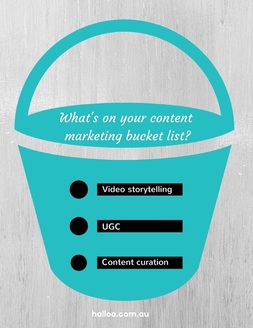 In other words - using your senses to get more creative with content and ooze with personality. Sight. Smell. Sound. Taste. Touch. When was the last time you used any of these in your content marketing? It's about making your content relatable, engaging and fun. Authors use this technique all the time, incorporating senses in their writing to capture attention and evoke emotions with the reader. It's how they draw you into their story and it's what makes you not want to put a book down - usually without even realising. The same can be achieved with your own brand storytelling. So let's break it down: Sight Around 65% of people are visual learners and the most common and easiest way to create imagery in writing is through sight. You do it all the time without realising, but next time you write something, why not take it beyond the obvious green tree? Just introducing the sense of sight will take your copy from sounding 'OK' to crafting something truly compelling that your audience will want to read and connect with. Smell Mmmm, does the scent of a particular fragrance ever remind you of anyone, or does the aroma of something baking in the oven bring you back to your childhood? The sense of smell is powerful - and don't dogs know it! A smell can bring back or recreate a sense of nostalgia, and you can accomplish this too with your brand storytelling. It's an effective way to get your audience lost in the moment. There are heaps of tips on how to describe a smell when writing, so all I can say is give it a go! Sounds Now this is where you can really get creative. Onomatopoeia sounds like an ominous word, but what it really means is words that imitate sounds in writing. If you're a comic book fan then you'll be all over this notion. Words like 'Kaboom' or 'Zap' are what I'm talking about. There's no limit to what you can come up with - making up your own words is half the fun. And who knows, it may even shape some of your brand language, if it gains enough traction! Another way you can use this sense is to use words that depict a sound. For example: Beep, crash, growl, slam, swoosh, yelp...I think you get what I mean here. Taste Did you know there are only 5 types of taste sensations your tongue can taste - sweet, sour salty, bitter and unami (savoury). But there are of course many different ways to describe these. If you're writing about food then for sure you'd be using this sense all the time. But if you aren't, then it might not be something you would naturally consider. So, one way you could use the taste sense is through describing a personality type. Using metaphors is another way you can introduce taste into your copywriting. Touch This is probably the trickiest of all senses to convey in copy. But the best way to approach this is to think about the sensations that relate to something you would touch. Consider temperature and texture when trying to integrate touch in your writing. For example, your feet on a sandy beach can feel smooth, velvety, silky, mushy or if it's hot sand - burning! Final thought: Don't over do it As a copywriter, I tell my clients all the time not to overuse exclamation marks. The same goes for this. You may think of yourself as the next Charles Dickens, but unless you're heading down the novelist's path, don't go hell-for-leather. Using this technique in your copy isn't going to work for all of your content marketing efforts, so just experiment where appropriate and be tactful. Too much and you might evoke the wrong kind of emotions from your audience. And, of course make sure it stays aligned with your brand language style.
2 Comments
 Have you ever been in a conversation where you’ve said something at the time that sounded right in your head but ended up in a face palm? Now imagine that happening to the company you work for, broadcast to a large audience across multiple mediums. Once your message is out there it’s not easy to erase, and it doesn’t take long for opinions to be formed, particularly when it hits social media. If you’re a Perth local, you may have heard about the recent West Coast Eagles ‘yellow peril’ promotion debacle. A member of the communications team made the reference twice on social media, which had intended to be in relation to the heritage jumper worn by the players during a game. What ensued was criticism across the Perth community. The staff member was unaware of the derogatory nature of the phrase (a term used in the 1900s to describe the fear of Asian immigration). An apology was issued from the top but the entire media frenzy could have been avoided if a little bit of homework had been done prior to hitting publish. Misleading your audience, whether intentional or not can damage your brand’s credibility – one that you’ve no doubt worked hard to maintain. An embarrassing and costly exercise you’d rather avoid! Even the big brand powerhouses sometimes get it wrong:
So, what can you do to avoid producing content that’ll have you thrown into the fire?
We can't all be copywriters but as Ann Handley puts it - everybody writes! I myself have been out of the game for a few months whilst having a baby, and i'll be the first to say it can be hard putting pen to paper when it's not something you've been doing every day. So, what do you do when you need to write engaging content for your customers? Not everyone has the luxury of a copywriter on hand to help draft the next piece of website content or promotion (although I could tell you of a few businesses in Perth that are lucky enough to) - it's up to you! With that in mind, here's some tips that I live by, should you need a little guidance the next time you're tasked with writing content. 1. Overcoming writer's block This is likely to be your first hurdle - procrastinating over the job because you have no clue where to start. We all experience this, but the best thing to do is just start writing - crazy right? Your first draft is exactly that. Don't try to overthink things, just scribble what comes to mind. You'll find that once you get going the ideas will start flowing. You can refine the finer details later but for now it's about getting the creative juices flowing. If you're more of a visual person then give mind mapping a go. Write your topic in the middle of a page and brainstorm everything related to it. There are no limits to this and it's a great way to generate ideas and your overall angle. 2. Make the most of your resources If you have specific brand and/ or language guidelines in place then refer to these - it's why they're there! This is especially handy when you've never had to write anything for your brand before. It will help you to capture the right style and tone of voice, and understand what is and isn't acceptable when writing content. 3. What's in it for them? Focus on 'you' not 'we' or 'us'. Put yourself in the customers' shoes and think about what the benefits are to them. This is what you should be highlighting and conveying as naturally as possible. Be conversational as if you were writing to your peers. No one wants to read boring facts or overused jargon that sounds cliched. Keep it simple and you'll come across much more genuine. Depending on the purpose of what you're writing, inject some of your own personality and experiences - the more you can humanise your content, the more believable you'll be. 4. Reviewing your copy Once you've written your draft, give yourself a break and let time pass before reviewing it again. Any mistakes or areas of improvement will be much more vivid to you after stepping away from your copy. Print out a copy (you don't blink as much when reading on paper) and read it out aloud. Edit any unnecessary words and refine your content as best you can. Try replacing some of your words with words that evoke imagery. This will create a visual impact for your readers - a thesaurus is good for this! 5. Read read read This is more of an afterthought but one worth noting. You can improve your writing by simply reading more (like Halloo's blog!). It will dramatically improve your vocabulary and ability to write engaging content. Exposing yourself to different genres will also help you creatively, so the next time you have to write some copy you won't feel so daunted by it. Happy writing :) Churning out original content on a regular basis is a challenge for many marketers, especially when you're a jack-of-all-trades and time isn't on your side.
But with a little bit of digging in your own backyard, you'll find that the people you work alongside every day can be a real asset to your content marketing, and soon enough the ideas will start flooding in. 6 ways you can look to your colleagues for content inspiration Tap into influencers and subject matter experts Speak right to the source about topics that matter to your company. Experts in their field provide credibility and help you become a thought leader in your industry, not just a sideline participator. Conduct interviews, set up live Q&A sessions and capture what you can visually to make your content even more engaging. I challenge you to go up as high as your CEO to get their opinion on absolutely anything - then share it with the rest of the world. Customer service can help you too Spend a little bit of time with your customer service team and you'll learn more about your customers than you could imagine. You may already have personas to base your content strategy on, but the real time interaction you'll gain is invaluable. These guys can tell you straight up the questions they get bombarded with on a daily basis and what annoys your customers. Bring those questions to the forefront and be proactive in demystifying any assumptions about a product or service you offer. It's also an opportunity to provide tips and advice, or simply create more brand awareness. Go behind the scenes Capture what goes on in the engine room of your operations. Whether it's with crew working out in the field or colleagues based in an office environment, there's always someone with a story to tell. Moments like these make for compelling video content! Reach out to the community Showcase the work you're doing in the community. Do you support any local Perth charities or do you volunteer your time to help others? How does this align with your brand? Happy go lucky Show them you're human too! Share staff events or company milestones as you're celebrating them. The more creative you can be the more engaging your content will be. Go back in time If you haven't done this already, conduct a content audit and scan your archives for interesting historical content and images. Then repurpose your content so it's relevant again. Depending on the size of your company you may already have a knowledge centre you can also take advantage of to generate even more content ideas. At Halloo, we're all about collaboration and it's a great way to keep the content wheel turning. We can't all be copywriters or content marketers, but if you've identified keen participants, consider decentralising your content marketing efforts and develop your own content team with the wider business. It can be something as simple as contributors sharing their ideas via a content calendar. The more perspective and interaction you can attract from within, the easier it will become to produce organic content and in turn make your brand shine.  Have you jumped into 2016 with a burst of fresh perspective and creative inspiration? Content marketing trends and predictions for the New Year are out, providing us all with some direction on what's hot and where we should be steering our efforts. But if you're a small business or have limited resources, you may feel like you're constantly playing catch up with the big guys and appear a bit out of reach for where your content marketing initiatives currently sit. With so much content saturation out there and technology growing at such a fast pace, it can be hard to keep up. No matter what stage your content marketing life cycle is at though, it doesn't hurt to set some goals to get motivated for the year ahead and align it with your marketing plan. And what better way than a bucket list to keep you on track! So... where to start? Think about what you're currently doing and how you might be able to build upon your existing content strategy (and if you don't have one then it should be on the top of your bucket list - Halloo can help you with this if you need a hand). Consider including in your bucket list a mix of small achievable targets and then throw in some 'big ticket' items that might not be attainable straight away, but sets the direction for where you'd like to be. Thought starters for compiling your content bucket list
And if there's one piece of advice you should take on board, it's choose the platforms that work best for you. Don't spread yourself thin across everything if you don't have the resources to dedicate the time to do it properly. Share you bucket list ideas with us! |




